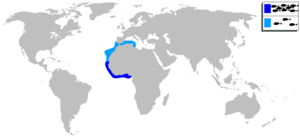Lusitanian toadfish facts for kids
Quick facts for kids Lusitanian toadfish |
|
|---|---|
| Conservation status | |
| Scientific classification | |
 |
|
| Distribution of Halobatrachus didactylus | |
| Synonyms | |
|
The Lusitanian toadfish (Halobatrachus didactylus) is a unique type of toadfish. You can find it living along the coasts of western Europe and western Africa. This includes areas from the Bay of Biscay down to Ghana. There was even an old sighting far north in Norway!
This interesting fish can grow up to 50 centimetres (20 in) long. It's known by different local names, like gripau in Catalan, charroco or xarroco in Portuguese, and pez sapo in Spanish.
Contents
About the Lusitanian Toadfish
The Lusitanian toadfish is a fascinating creature of the sea. It's known for its unique sounds and how it lives hidden on the seafloor.
Where It Lives
This toadfish prefers to live in shallow waters. You'll often find it on soft sand or muddy bottoms. It likes to hide by burying itself partly in the sand. Sometimes, it also finds shelter in rocky cracks. These fish usually live alone, not in groups. They can be found at depths of less than 60 metres (200 ft).
What It Sounds Like
The Lusitanian toadfish is quite noisy! It makes many different sounds. These include whistles, grunts, and croaks. One special sound is called a "boatwhistle." The fish uses this sound for two main reasons. Males use it to attract females when they want to mate. They also use it to warn other males to stay away from their territory.
What It Eats
The Lusitanian toadfish is a predator. This means it hunts and eats other sea creatures. Its diet mainly includes crustaceans, like crabs and shrimp. It also eats molluscs, such as snails and clams. Smaller fish are also on its menu.
Reproduction and Life Cycle
Lusitanian toadfish are oviparous. This means the female lays eggs. After the eggs are laid, the female leaves. The male toadfish then takes over. He guards the eggs until they hatch, making sure they are safe from danger.
Fishing and Importance
While the Lusitanian toadfish is not a major target for big fishing companies, it is sometimes caught. Local fishermen might catch it as part of their daily fishing. It can also be caught by accident, which is called bycatch. When caught, it's usually sold fresh. Sometimes, it's used to make fishmeal or oil.


